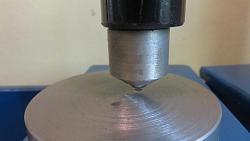The idea here is to use a regular shop press plus a bearing ball to conduct a Brinell test.
My goal is identify unknown steels and relate brinell hardness with ultimate strenght.
There is a formula witch relate load, ball diameter and indentation to material hardness:
https://me-mechanicalengineering.com...hardness-test/
I Made the "holder" for 10mm (3/8") ball. The holder let only 3mm (1/8") of the ball exposed.
For sure the holder is a must if you doesn't want to brinell test your press ram.
Tested some 1020, 1045, A36, SCH80 and AL 6061 I have at scrap bin.
Problems found:
* My readings ended being a bit off expected numbers. Had a tough time taking precise measurements with a paquimeter. I Had read that there is a dedicated microscopes for this....maybe a good photo and convert pixel to mm....this will be my next try.
* Not know the shop press manometer error. Need a way to check it.
Hazards: At 3tons, there much risk of ball bearing exploding? Use safety glasses!


 LinkBack URL
LinkBack URL About LinkBacks
About LinkBacks







 Reply With Quote
Reply With Quote








Bookmarks